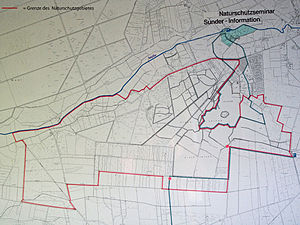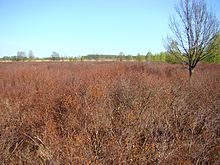Meißendorfer ponds / Bannetzer moor
|
Meißendorfer ponds / Bannetzer moor
|
||
|
Overview of the nature reserve |
||
| location | Northwest of Winsen , southeast of Hodenhagen , in the district of Celle | |
| surface | 815 ha | |
| Identifier | NSG LÜ 098 | |
| WDPA ID | 164601 | |
| Geographical location | 52 ° 43 ' N , 9 ° 49' E | |
|
|
||
| Sea level | from 29 m to 47 m | |
| Setup date | 06/16/1984 | |
| administration | NLWKN | |
The Meißendorfer ponds with the Bannetzer Moor are a nature reserve and bird sanctuary of national importance on the edge of the Lüneburg Heath . The special importance of the NSG is underlined by its recognition as a major nature conservation project of the federal government. The area got its name from the nearby small towns of Meißendorf and Bannetze .
geography
The Meißendorfer Teiche / Bannetzer Moor nature reserve is located about 7 km northwest of the municipality of Winsen an der Aller , and about 40 km north of Hanover. In the north, the Ostenholzer Moor borders almost directly on the nature reserve, the Meiße runs between the Ostenholzer Moor and the Meißendorfer ponds. The Allertal extends a few kilometers south of the area . The nature reserve with its once marshy meadows is part of the Ostenholz Moor. The landscape emerged as a glacial valley of the Aller during the Ice Age . Towards the end of the Ice Age, strong winds blew up a dune wall on the northern edge of the valley, so that the water coming from the north could no longer drain away and a large moor formed.
Origin and history
Good Sunder
The Sunder estate has its origins in a Freihof of the St. Michaelis monastery in Lüneburg , with the church as the landlord. The Lüneburg Chancellor at the Celler Hof, Baltasar Klammer, was enfeoffed in 1548 by Abbot Herbold of the St. Michaelis Monastery with the possessions of the Monastery in Meißendorf. He moved the farm from the town of Meißendorf to the vicinity of his lands. This is where the origin of the name comes from: separate, special, sunder . On a square surrounded by ditches with small ponds, a mansion was built in the representative style of the town houses in Celle. After the estate had changed hands several times, Gottlieb Ludewig von Schrader acquired Sunder in 1752 (according to the inscription on his tombstone: * November 8, 1695; † December 23, 1760, Royal British and Elector Braunschweig-Lüneburg Court Councilor). In 1881 a family cemetery was set up northwest of the estate, in the forest on the Meiße, which has been preserved to this day. In 1977 the von Schrader family had to sell the estate for financial reasons. In 1980, the German Association for Bird Protection (DBV) (now NABU ), together with the federal government, and thanks to the financial participation of IBM , acquired a large part of the site in order to secure the preservation of this important wetland habitat. The NABU Landesverband Niedersachsen now maintains a regional environmental education and nature experience center with a seminar. The manor house is now a listed building and is considered the most beautiful secular building on the heath.
- NABU Gut Sunder
Pond management
In 1881, the then owner of the Sunder estate, Ernst von Schrader, started pond management. 51 larger and smaller ponds were created on the heather and bog areas. The Meiße, a small river that flows into the Aller near Hodenhagen , has been canalized and has been feeding the ponds with water ever since. In 1892 he planted 10,000 carp eggs in his oldest pond, 2 hectares in size. The largest carp farm in northern Germany emerged. In the 1960s and 1970s, extensive fish farming was largely stopped. The Meiße has been renatured in sections. In the northwest of the Sunder estate, the Meiße is back on its old course.
Geography, fauna and flora
The total area of Meißendorfer Teiche / Bannetzer Moor covers 815 hectares, the water surface itself, with 80 fish ponds, is around 350 hectares. It forms the largest water landscape in the Lüneburg Heath. The nature reserve includes:
- Pond areas in different stages of succession,
- Parts of the Meissen lowlands with meadows and alder forests,
- valley sand areas with pine trees in the north and east,
- Degenerated and cultivated areas of the Bannetz Moor with still small-scale remains of raised moor,
- large areas of the moorland that are exclusively covered by the gale bush.
In the pond area, which is particularly well-known for its rich bird life, around 130 breeding bird species, of which around 40 are endangered, and over 60 resting bird species have been identified. In addition, about 40 dragonfly and over 400 butterfly species live there. The area is gaining importance as a breeding ground, and in autumn also as a resting and sleeping place for the cranes , since some ponds have only been dammed shallow. The stocks are increasing continuously. Up to 100 resting cranes have been counted, presumably coming from the surrounding breeding areas of the Bergen military training area or the Südheide . The sea eagle first returned to the area in 1995. Between 1997 and 2005, 14 young eagles were successfully raised in the nest, which is guarded by nature conservationists. In addition to the Meißendorfer ponds, the eagle uses the nearby Ostenholz Moor and the Bergen military training area as a hunting ground.
Breeding birds
One finds here z. B. White-tailed eagles , ospreys , reed warblers , bitterns , teal ducks , lapwing and corncocks , just to name those that are on the Red List of endangered or endangered bird species. But birds like kingfishers , cranes , Beutelmeise , Little Grebe , Water Rail , Reed Warbler , grebes , cormorants , herons , Gray Goose , Gadwall , Pochard , Barn Owl , Black-headed Gull , Marsh Harrier , Bless Rail , Northern Shoveler , Sperber and Red Kite have their breeding territory here.
- Breeding birds in the pond area
Island with cormorants and incoming bean geese
Guest birds
Here, too, we find numerous birds that are listed on the red list . Sandpiper , ruff , redshank , black stork , goosander and dunlin . In addition, Siskins , Water Pipit , Bewick's swan , whooper swan , hen harrier , ringed plovers , sandpipers , Smew , Common Gull , wigeon , pintail , black tern , crossbill and Redshank .
fishes
In the ponds and streams swim pike , carp , tench , roach , bream , rudd , crucian carp , bream , ruffe , bitterling , eel , perch , three-spined stickleback , dwarf stickleback , bullhead , loach , brook trout , gudgeon and brook lamprey .
plants
The nail bush , which is on the red list of endangered plant species, grows on a pond dam . At another, protected in part plants can be found here Teichrose , downy birch , crab claw , bittersweet nightshade , Utricularia intermedia , Sparganium natans , Lysimachia Thyrsiflora , swamp yarrow , Sparganium erectum , water hemlock (very toxic), Sechsmänniges waterwort , pseudacorus , Wasserdost .
Others
The otter , which is very rare and shy in Germany and which was almost extinct here, settled again. Of protected amphibians and reptiles, we find grass snake , frog , marsh frog , spadefoot , moor frog and great crested newt . The two-striped spring damsel , which is endangered in its kind in Germany, lives in the area.
Tourism
Around the 35 hectare Hüttensee, which protrudes into the nature reserve, but is not part of the reserve itself, a 4.6-kilometer circular path has been laid out, from which numerous rare bird species can be observed. Many ornithologists from all over the world visit this area every year. There is a campsite on the edge of the Hüttensee. NABU Gut Sunder with its hiking trails and its signposted circular route is always open. The info shop and the NABU Wildlife Exhibition open from April to October after posting.
The first movie by the famous nature filmmaker Heinz Sielmann (“Song of the Wild”) was made at the Meißendorfer ponds in 1948 .
- Hüttense
literature
- Ernst Andreas Friedrich : Natural monuments of Lower Saxony . Hanover 1980, ISBN 3-7842-0227-6
Individual evidence
- ↑ NABU Gut Sunder
- ↑ August Scheller: The memory - home book for the district of Celle v. 1930
- ↑ NABU Wildlife
Web links
- Nature reserve "Meißendorfer Teiche / Bannetzer Moor" in the database of the Lower Saxony State Office for Water Management, Coastal and Nature Conservation (NLWKN)
- Flora and fauna of Gut Sunder, the Meißendorfer ponds and the Bannetzer Moor , website of the NABU Academy
- http://niedersachsen.nabu.de/nabu/zentren/gutsunder/
- The nature conservation project (leaflet from LK Celle) (PDF file; 1.6 MB)


















